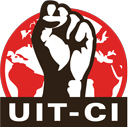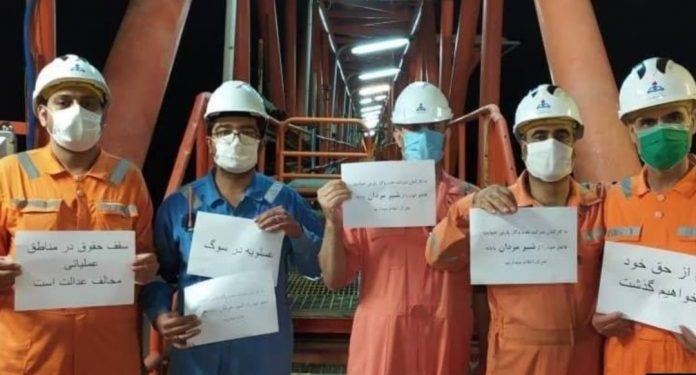by Miguel Lamas
23 July 2021
Over 60,000 workers in oil and gas fields and petrochemical plants in 112 companies have been on strike across Iran since 19 June. They are the largest strikes since the 1979 revolution. The strikers are demanding wage rises, the ending of temporary contracts and special zones, an end to oil privatisation, renationalisation, and the right to form independent trade unions.
The so-called “1400 Strike Campaign”, referring to the current year of the Iranian calendar, was coordinated nationally by strike committees.
The strikes began one day after the national elections won by the cleric Ebrahim Raisi, which had a majority popular abstention and boycott by large sections of workers.
The state-owned National Iranian Oil Company centralised the oil industry. Privatisation through contracting companies, most of them controlled by state officials and their relatives, who get contracts with the state-run company, pay their workers barely breadline wages and impose super-exploitative working conditions, with no right to unionise. They also created special economic zones where labour laws do not apply.
The state oil company workers have not yet joined in the strike. They get wages three times higher than in the private sector, and labour laws protect them. However, they could do that in
the future, adding their demands.
Street demonstrations and statements by teachers, pensioners and families seeking justice for their relatives killed during the great wave of protests in November 2019, where the repressive forces killed 1500 people, add to the strike. Peasant sectors have also mobilised with their demands and movements for women’s liberation in the Islamic dictatorship.
The 1979 revolution
Today Iran has 83 million inhabitants. One of the world’s largest oil producers, competing with its rival Arab Middle Eastern neighbours, Saudi Arabia, the Gulf states and Iraq. After WWII, the US subordinated Iran to its imperialist interests. In 1953 a coup d’état brought the Shah (emperor) to power, and US companies controlled all oil production.
In 1979, a popular uprising overthrew Shah Mohammad Reza Pahlavi. Workers, especially oil workers, played a central role in the insurrection, forming “shoras” or workers’ councils, bodies of power that controlled the oil industry and other sectors. The government expelled US companies, and it nationalised the oil.
The Islamic Republic
But in the absence of revolutionary leadership that called for the shoras to take power, the Islamic clergy took over, led by Ayatollah Ruhollah Mousavi Khomeini. He had great popular support because of the weight of the Shiite Islamic Church.
They founded the Islamic Republic, a religious state. It dissolved the workers’ councils and established repressive laws against women, workers’ organisations and any dissident sector. The government created the Islamic Guard. It is a bloodthirsty and ultra-repressive military body.
The Islamic Republic is capitalist: the benefits of the nationalisation of oil did not reach all. And as we pointed out, it is re-privatising oil and now links up with Chinese imperialism with which it has just signed a $400 billion investment treaty in energy and infrastructure.
Since the 1979 revolution, the Islamic Republic has maintained relative political and economic independence from the US and Europe, with repeated clashes with the US and Israel, and US sanctions. Today, Trump’s sanctions are in place, punishing Iran by blocking the sale of its oil in retaliation for developing an atomic energy programme. These sanctions sped up the economic crisis, which the pandemic aggravated. This crisis was dumped squarely on the working people, with job insecurity, high inflation of over 50 per cent, low wages, and the collapse of services such as electricity and water. Hence the discontent and popular protests in 2019 and the current strikes.
Long live the oil strike! For a workers’ way out of the crisis!
That the strike has been going on for a month shows the strength of the Iranian working class. If the workers of the state enterprise join the strike, the movement can become unstoppable. The struggle to take up and overcome the revolutionary experience of 1979, betrayed by the ayatollahs, will be posed. We need a revolutionary socialist leadership to move forward. To recover the process interrupted in 1979: a government of the shoras, workers’ councils, and the emerging mass organisations.
The new government of Raisi, an old repressive former Justice chief authority, who will take office in August, is extremely weak, because of the huge electoral abstention and the wave of strikes. There are divisions in the Iranian capitalist class. One sector wants an agreement with the United States to support its oil business, while the dominant line is oriented towards agreements with China.
The current or the new government may try to negotiate with the strikers and make some concessions.
But a new revolutionary process is underway in Iran, which the bloody repression in 2019 failed to crush. Although the mobilisation has not yet reached the mass scale it had in 2019, the political and social crisis means that it is likely to expand.
The strikers’ programme is to return to the total nationalisation of oil, and this implies liquidating the most concentrated sector of the bourgeoisie linked to the regime and confronting the new submission to imperialism, be it American or Chinese, that the government and the different bourgeois factions are trying to impose.













